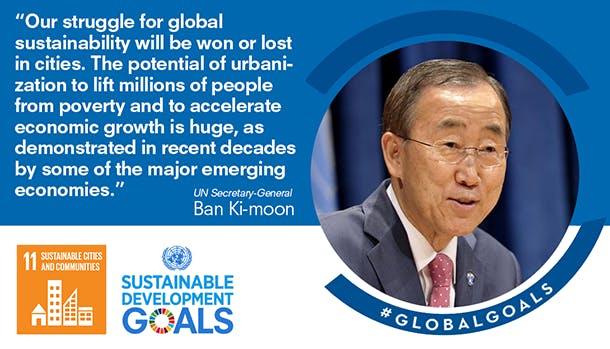
“Achieving its 17 Sustainable Development Goals will depend, in large part, on whether we can make cities and human settlements inclusive, safe, resilient and sustainable.” – United Nations Secretary-General Ban Ki-moon message on World Habitat Day
By 2030, 6 in 10 people will live in urban areas, according to the UN. That means that urban areas pose significant challenges and opportunities for sustainable development. Goal 11 of the Sustainable Development Goals calls to “Make cities and human settlements inclusive, safe, resilient, and sustainable” by 2030.
From October 17-20, the UN is hosting the Habitat III conference on housing and sustainable urban development, which is taking place in Quito, Ecuador.
The UN says: “The Habitat III Conference therefore has, as its mission, the adoption of a New Urban Agenda an action-oriented document which will set global standards of achievement in sustainable urban development, rethinking the way we build, manage, and live in cities through drawing together cooperation with committed partners, relevant stakeholders, and urban actors at all levels of government as well as the civil society and private sector.”
As the Habitat III conference brings people from around the world together to talk about the future of urban areas, here are five statistics from the UN from the UN that show the importance of this issue.
Almost a third of the urban population in developing regions still live in slums.
Although the percentage of those living in grim conditions has declined in the past, more than 880 million people around the world continue to live in slums. Since people continue to move to cities in search of greater opportunity, more action is needed to make sure people can live in safety and dignity.
In 2014, about half the urban population worldwide was exposed to air pollution levels at least 2.5 times above the safety standard set by the World Health Organization (WHO).
According to WHO, more than 80% of people living in urban areas that monitor air pollution are exposed to air quality levels that exceed its limits, with populations in low-income cities are the most impacted. This has serious impacts on health. In 2012, an estimated 6.5 million deaths were linked to indoor and outdoor air pollution.
95% of urban expansion in the next decades will take place in developing countries
As more people move to cities and urban areas expand, there is an opportunity to make sure urban development is sustainable development. On the other hand, if we don’t make sure this growth is sustainable and inclusive, we risk exacerbating global challenges like inequality and poverty.
The world’s cities occupy just 3% of land, but account for 60-80% of energy consumption and 75% of carbon emissions.
Cities are critical to addressing the threat of climate change given their large share of emissions. Yet many cities are taking leading roles in acting on climate change, providing an example of how cities can promote sustainability for people and the planet.
Three-quarters of countries have implemented or are working to implement national level urban policies.
National policies and regional development plans can spur progress on sustainable development. As implementation of the global goals gears up, local and national policies and plans provide an important vehicle to promote sustainable urban development that leaves no one behind.
To learn more about the Habitat III conference and its outcomes, visit habitat3.org.



 View All Blog Posts
View All Blog Posts